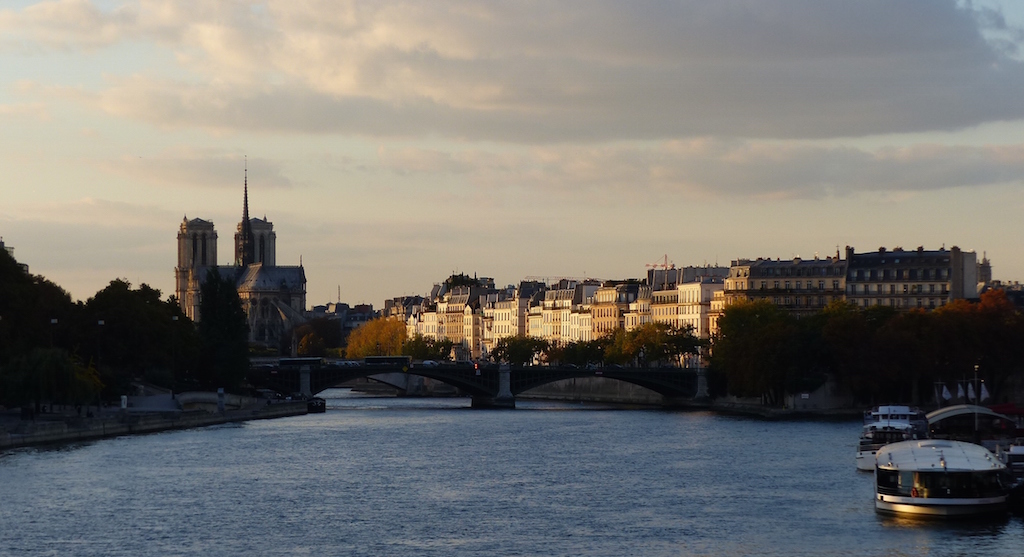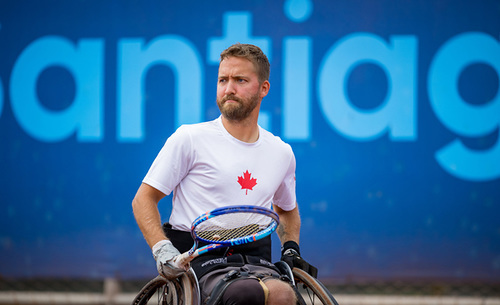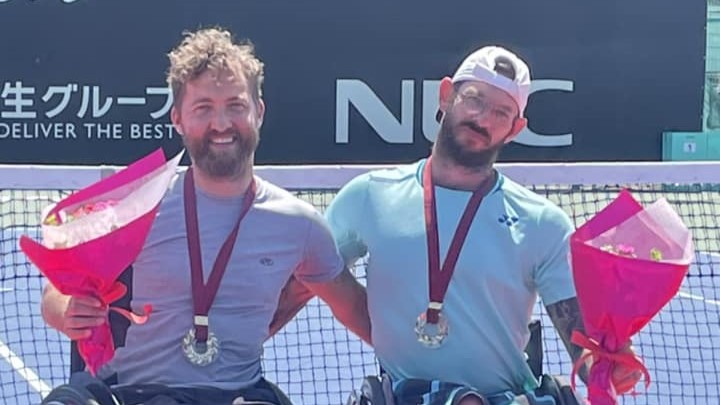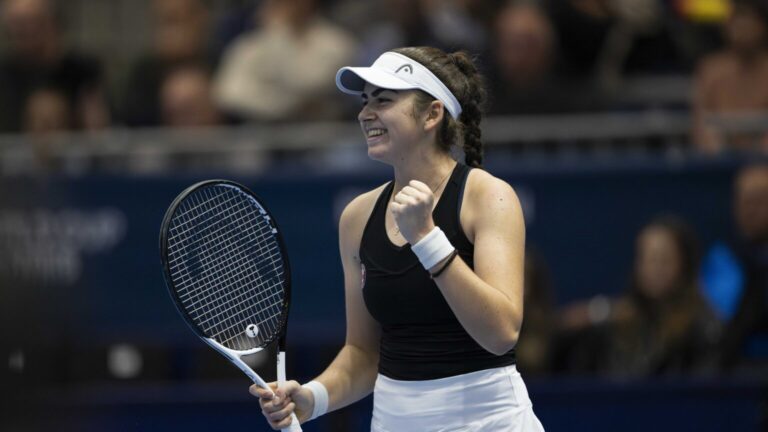
Paris can be beautiful at this time of year as can be seen in a view this week from the Austerlitz bridge over the Seine.
Milos Raonic has been in the City Of Light for over a week but most of his time has been spend trying to re-energize a game that has been subpar, by his standards, since his Wimbledon final back on July 10.

Putting in the hard yards at the Accor Hotels Arena with coach Carlos Moya has obviously paid off and on Friday he reached the semi-finals with a dominating 6-2, 7-6(4) victory over Jo-Wilfried Tsonga.
He broke Tsonga in the very first game and really gave the charismatic Frenchman no chance – serving huge and walloping the forehand with the kind of conviction that shows how confident he is.
On Thursday night, Tsonga lost the opening set 6-0 to Kei Nishikori before saving two match points and coming back for a heart-stopping 0-6, 6-3, 7-6(3) victory. He was booed by some in the Centre Court crowd for the first-set drubbing but there was none of that on Friday evening after the first set. It was almost as if spectators could see that their man was trying his best but was simply being outplayed by an almost unplayable Raonic.
At one point French TV commentator and former player Lionel Roux exclaimed after a particularly potent Raonic second serve, “his second serves are like Nishikori’s first serves last night.”
It was an excellent service night for Raonic – his ace count was a fairly modest 16 but he made 63 per cent of his first serves and won 80 per cent of them along with an sparkling 71 per cent of second serves against the 11th seeded Tsonga.
“He was serving great and then when we went to the tiebreak I wasn’t as aggressive as I should have been,” Tsonga said. “But then it was just his serving and there weren’t any rallies.”
As for Raonic, he said, “it’s always tough playing Jo here in Paris but I have an advantage with my serve. The crowd can be cheering loudly but if I hit a good serve, that changes everything. That’s an advantage I have with my game.”
It is amazing how Raonic has turned that game around after a humbling 3-6, 6-3, 6-3 loss to No. 91-ranked qualifier Ricardas Berankis of Lithuania in his opening round in Basel 10 days ago.
“I’ve had some really good weeks and I’ve had some pretty bad weeks this year, so that was one of those,” Raonic said last weekend about the Berankis match as he prepared for the BNP Paribas Masters. “It doesn’t really take too much to turn those around so hopefully I can play some better tennis here.”
The key moment this week may have been at 5-all in the first-set tiebreak of his opening match against world No. 31 Pablo Carreno Busta of Spain. Raonic pounded a forehand down-the-line that the Spaniard couldn’t return and then finished off the set with an ace on his way to winning 7-6(5), 6-4.
He was a little off in the first set of his 4-6, 6-1, 6-2 over No. 16 seed Pablo Cuevas in the round-of-16 but the second and third sets were vintage displays of Raonic seizing control with his attacking tennis.

That carried over into the match Friday against Tsonga – except for the occasional glitz, he was sharp and unrelenting in asserting his superiority on the court – finishing with a count of 33 winners and just 20 unforced errors.
He will probably have to step that up again on Saturday in the semifinals against Andy Murray, with the current world No. 2 having a chance to finally reach No. 1 after Novak Djokovic was upset by Marin Cilic in another Friday quarter-final.
Murray leads the head-to-head with Raonic 8-3. But most noteworthy is that he has won all five meetings in 2016 – Australian Open semifinal 4-6, 7-5, 6-7(4), 6-4, 6-2, Monte Carlo quarter-final 6-2, 6-0, Queen’s Club final 6-7(5), 6-4, 6-3, Wimbledon final 6-4, 7-6(3), 7-6(2) and Cincinnati semifinal 6-3, 6-3.
The Monte Carlo result is rather brutal but Raonic was in winning positions at both the Australian Open and Queen’s Club so can feel he is due for a win, especially because he seems to have worked out the ligament tear in his right ankle that is now well-taped and not inhibiting him.
“The pressure could be big on him with a first chance to be the world No. 1,” Raonic said looking ahead to the semifinal versus Murray. “So there’s a lot riding on it for him and a lot riding on it for me. I’ve got to serve well and control the centre of the court more than I have the last couple of matches. I’ve played a lot of matches against Andy this year and I hope I can change what’s gone on up to now.”

Raonic has been in a semifinal before at the BNP Paribas Open – exactly two years ago when he beat Tomas Berdych after coming up with a 7-6(5), 7-5 victory over Roger Federer in the quarter-final. That was a landmark run for the then 23-year-old because it included his first ever against the great Swiss following six straight losses.
It’s now only five consecutive losses to Murray this year but a win to break that losing streak and to deny Murray his long coveted goal would be sweet for Raonic.
Murray’s riding an 18-match winning streak and has to be feeling some fatigue playing a tournament (Beijing, Shanghai, Vienna and now Paris) for the fourth time in five weeks in his quest for No. 1.
He had good fortune when Raonic injured his adductor in the Aussie Open semifinals when the Canadian led two sets to one and was an extremely very close line call from taking a set and 4-1 lead in the final at Queen’s Club. A strong effort in the semifinal on Saturday not before 16:30 p.m. (11:30 a.m. ET in Canada) and he could play spoiler in Murray’s bid for the top spot.
And Raonic has a ranking goal of his own that he’s chasing this week as well as at the ATP World Tour Finals in London in two weeks. “He’s playing for No 1,” the current world No. 5 said, “but I have a goal too – to finish No. 3 (ahead of current No. 3 Stan Wawrinka).”
Nestor in Paris semis

Daniel Nestor’s mantra about doubles is that almost every match comes down to a few points. That’s certainly often the case but a mantra subset is that once big “mo” shifts in a match it can be a pretty dramatic course change.
On Friday evening in cozy and slightly claustrophobic Court 1 at the BNP Paribas Masters in Paris, Nestor and Rohan Bopanna survived a lopsided first set to eventually overcome unseeded Americans Jack Sock and Nick Monroe 2-6, 6-3, [10-5].
Bopanna dropped his serve in the opening game and the Nestor did likewise at 2-4 and that was pretty well the story of the first set.
The second looked good for Nestor and Bopanna when they opened up a 3-0 lead but the 36-year-old Indian lost his serve at 3-1 and matters became highly competitive again – until Monroe dropped serve by chunking two forehand volleys in a row at 3-4 and after being up 40-30 in the game. Bopanna then served out the set on four quick points.
On the first point of the ensuing match tiebreak, Bopanna ripped a backhand down-the-line service return winner past Sock at the net and he and Nestor were off – building a 4-0 advance on the way to soon leading 9-2. The final score was 10-5 to move the No. 8 seeds into a semi-final on Saturday against top seeds Nicolas Mahut and Pierre-Hugues Herbert.
“It was a weird match because I thought they were the better team and then it turned around quickly,” Nestor said, “one missed volley (by Monroe) in the second set and then we got off to a good start in the (match) tiebreaker. That’s the thing about doubles, you can lose the momentum very quickly.”
The odd man out on court in a group included Sock ranked No. 11, Nestor No. 17 and Bopanna at No. 22, was the 34-year-old Monroe at No. 62.
He’s the one who cracked in the pivotal eighth game of the second set but Nestor didn’t come down hard on him. “He’s been playing pretty well this year and he played well for the whole match,” Nestor said about Monroe. “It was just that one game. I think that the difference between a guy ranked 10 in doubles and 40 or 50 or whatever he is, is very small nowadays.”
When it was suggested that Sock may have been tired after losing a three-set singles quarter-final to John Isner earlier in the day, Nestor didn’t buy it and re-emphasized the vagaries of doubles. “Today’s an example of how things can change quickly. We got a break and all of a sudden we were up 4-0 in the (match) tiebreaker. It was kind of strange. We felt like we were out of the match and all of a sudden we’re winning. Typical of doubles, we could have been out of here in the first round (a 14-12 match tiebreak win over Lucas Pouille and Jo-Wilfried Tsonga saving a match point) and now we’re in the semi-finals. Every week it’s one point, two points – you never know what’s going to happen.”

When Nestor was asked about his level, which has been impressive through his first two matches, he responded with an answer that included a surprise revelation about who his partner will be in 2017. “I don’t think my level fluctuates that much – unfortunately trying to find the right partner is not east at my age. It’s obviously going to be a battle moving forward.
“I’m playing with (Philipp) Petzschner next year and, when healthy, he’s so talented. I’m looking forward to that opportunity, but hopefully he’s healthy. That’s the only thing that can hold us back.”
The 32-year-old German currently ranks No. 59 but has been as high as No. 9 in April, 2011. He played 13 events in 2016 and was runner-up three times – Qatar, Rotterdam (where he and Alexander Peya beat Nestor and Jamie Murray in the opening round) and Acapulco, all with Peya.
But he suffered injury again and didn’t play from April until October. At his best he can be formidable – as was shown by his winning Wimbledon in 2010 and the US Open in 2011, both with Jurgen Melzer.
Nestor continued about his current situation at age 44, “when I’m healthy I feel like I’m playing at a pretty decent level, by no means at the top of the world but I feel I still can compete with the top players. I’m enjoying these opportunities and these moments while I still can.”
About the process of lining up a partner for next year, he conceded, “people weren’t breaking my door down – let’s put it that way. I was playing well in the summer and then I got injured (calf) at the US Open and that probably scared guys off. But I’m the same, you see something like that and you kind of lose faith. Then a few months later it’s like ‘maybe I should have done that’ – that kind of deal. It’s typical of doubles but I got to make the most of it. All I can control is my game and how well I’m playing. That’s what I’m going to focus on and hopefully I can have the right partner beside me.”
About facing Mahut and Herbert in Saturday’s semi-finals, in what will be he and Bopanna’s first match on the Accor Hotels Arena 15,000-seat centre court, Nestor said, “they’re the No. 1 team this year, they won a Slam (Wimbledon), they’ve won several Masters 1000s and we’re playing in France so it’s going to be a similar crowd to what we saw first round (against Pouille and Tsonga). They’re very talented players and if we’re going to win we’re going to have to play our best and really understand that we’ve got to go for it.”
Regarding moving into centre court, Nestor noted, “I hear it’s playing fast so I’m looking forward to getting out there – I like fast courts.”
Pospisil, Melo win a close one

Vasek Pospisil had reason to take a few deep breathes – he and Marcelo Melo survived some tense moments before pulling out a 3-6, 6-3, [10-8] quarter-final victory over Grigor Dimitrov and Aisam-Ul-Haq Qureshi at the BNP Paribas Masters in Paris on Friday.
The Canadian-Brazilian No. 6 seeds certainly had a strange beginning to the match. Pospisil held serve in the second game despite hitting three double faults in a row after getting up 40-love. In the fourth game, Melo was broken and the Dimitrov-Qureshi duo closed out the set without facing a break point.
The second set was close with few extended rallies – big serving and hit-and-miss returning are the order of the day on the slick GreenSet indoor courts. But Melo clubbed a great return to break Dimitrov in the eighth game and soon the outcome was to be decided by a 10-point match tiebreak. Pospisil and Melo trailed almost from the beginning and were behind 6-5 with Qureshi having two serves to come. That was probably the critical juncture of the match tiebreak. On the first serve, Pospisil belted a hard, low forehand service return that ambushed Qureshi and he couldn’t manage a reply.
So instead of being 7-5 up with another serve to come for Qureshi-Dimitrov, it was 6-all and Qureshi then hit what seemed like an ace. He celebrated for an instant before realizing it had been called out. He walked up to the net and asked for a Hawk-Eye review which showed that the ball landed slightly outside the centre service line. Qureshi then walked back the baseline and promptly, after the interruption, double-faulted to relinquish the lead – 7-6 for Pospisil-Melo.
It got to 8-6 but Pospisil missed a backhand volley to reduce the advantage to 8-7. But he redeemed himself on the very next point with a screamer inside/out forehand service return that Dimitrov couldn’t handle and that was all the separation his team needed. Two points later they had the match and spot in Saturday’s semi-finals against the unseeded pairing of Henri Kontinen of Finland and John Peers of Australia, upset 6-2, 6-4 winners on Friday over third seeds Bob and Mike Bryan.

“It was not the cleanest match to be honest,” Pospisil said about his second match playing alongside Melo, “one of those matches where you just try to stay very positive because personally I didn’t feel I was playing that great.”
Regarding the two bomb service returns he hit at crucial times in the match tiebreak, Pospisil said, “I just tried to think about some technical things there and that helped. It was good timing for sure.”
Lovers of subtlety and angles and doubles dipsy-doodling will be disappointed with the rather brutal game-style on display at the Accor Hotels Arena in Paris. “They court is fast so it was just typical doubles especially if two guys are serving as well as they (Dimitrov and Qureshi) were serving. We didn’t have many opportunities and then the ones we had we played well. Marcel hit an unbelievable return to break in the second and then we both hit some great shots to win it at the end.”

After Paris, Pospisil will head to Bratislava, Slovakia, to play an 85,000 Euro ($94,500 US) Challenger event. “I just had it in my schedule to end the year on a positive note,” he explained. “I felt like I’ve been playing better the last few months so I need to get my ranking (ATP singles No. 136) up there and I may need to play a couple of Challengers to do that. Even if it’s a really strong field and even if I win the tournament I won’t make the main draw of the Aussie Open so I’m really just going with not too much riding on it but I definitely want to end the year well.”
He could then travel to the Czech Republic to visit family. “I may go for a day or two but then I’ll try to get home to Canada to see my brothers and parents as quickly as possible,” Pospisil said.
About his relatives still in the Czech Republic, Pospisil noted, “I have a grandmother and aunts and uncles and cousins from my mom’s side and some uncles and aunts from my dad’s side as well.”
He will train in the off-season in California in Los Angeles and Palm Springs, near Rancho Mirage where his new coach Mark Woodforde resides.
He said he might move off-tour training from Bradenton, Florida, to Los Angeles.
“I’m going to see how it goes now in L.A. and if I like it there I may move my base. I’ve been in Bradenton for a long time and feel like I need to change up.”
When it was suggested that he may be “going Hollywood” Pospisil just laughed, “I’m too old to get influenced that way.”
Post card

Massive crowds gather at the front of Notre Dame cathedral, which dates back to the 12th century, but this view from the backside by the Seine is maybe just as nice – and a lot more peaceful.
NOTE: Blog returns with Tebbutt Tuesday and a wrap-up of the BNP Paribas Masters.


